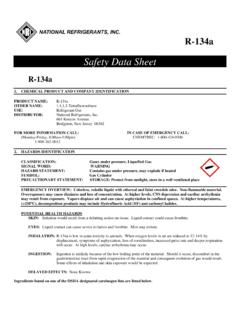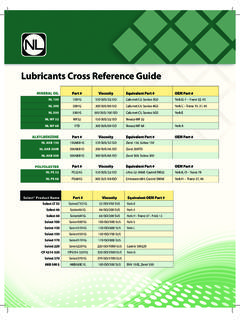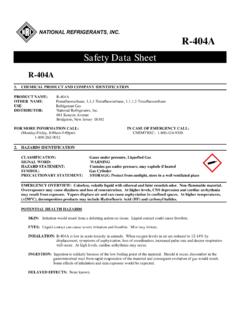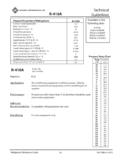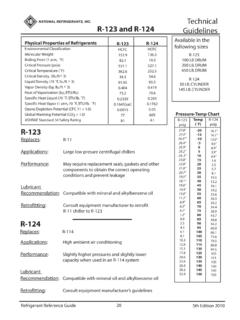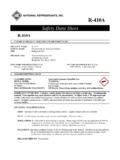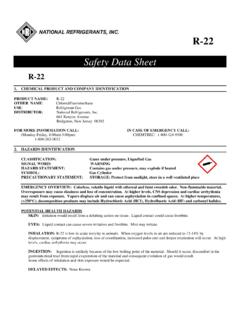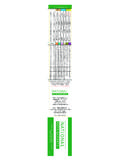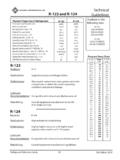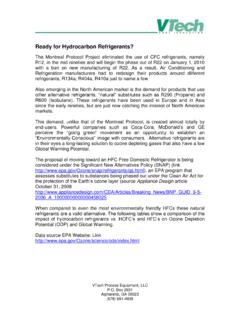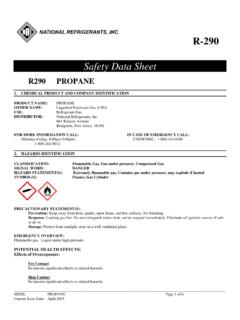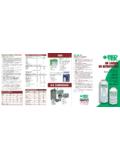Transcription of R-123 - Refrigerants
1 R-123 . Safety Data Sheet R-123 . 1. CHEMICAL PRODUCT AND COMPANY IDENTIFICATION. PRODUCT NAME: R-123 . OTHER NAME: 1,1-Di-chloro-2,2,2-trifluoroethane USE: refrigerant Gas DISTRIBUTOR: National Refrigerants , Inc. 661 Kenyon Avenue Bridgeton, New Jersey 08302. FOR MORE INFORMATION CALL: IN CASE OF EMERGENCY CALL: (Monday-Friday, 8:00am-5:00pm) CHEMTREC: 1-800-424-9300. 1-800-262-0012. 2. HAZARDS IDENTIFICATION. CLASSIFICATION: Specific Target Organ Toxicity (Central Nervous System) . Single Exposure Category 3. SIGNAL WORD: WARNING. HAZARD STATEMENT: May cause drowsiness or dizziness SYMBOL: Exclamation Mark PRECAUTIONARY STATEMENT(S): PREVENTION: Avoid breathing vapors RESPONSE: If inhaled move victim to fresh air and keep at rest in a position comfortable for breathing STORAGE: Store in a well ventilated place.
2 Keep container tightly closed. Store locked up. DISPOSAL: Dispose of contents/container at an approved disposal facility. EMERGENCY OVERVIEW: Colorless, volatile liquid with ethereal and faint sweetish odor. Non-flammable material. Overexposure may cause dizziness and loss of concentration. At higher levels, CNS depression and cardiac arrhythmia may result from exposure. Vapors displace air and can cause asphyxiation in confined spaces. At higher temperatures, (>250 C), decomposition products may include Hydrochloric Acid (HCI), Hydrofluoric Acid (HF) and carbonyl halides. POTENTIAL HEALTH HAZARDS.
3 SKIN: Prolonged and/or repeated contact with this solvent can cause irritation of the skin (defatting of skin). EYES: Irritant. Liquid contact will irritate and may cause conjunctivitis. INHALATION: When oxygen levels in air are reduced to 12-14% by displacement, symptoms of asphyxiation, loss of coordination, increased pulse rate and deeper respiration will occur. Overexposure to vapors may cause temporary anesthetic effects such as dizziness, headache and confusion. At higher levels, cardiac arrhythmia may occur. In repeated exposure tests with animals, changes were noted in liver functions and lipid production at levels above 100 ppm.
4 In isolated incidents with workers, overexposure to solvent vapors resulted in elevated liver enzyme levels. Liver enzyme levels returned to normal after overexposure ceased. R-123 . INGESTION: Discomfort due to volatility would be expected. Some of the inhalation effects could be expected. DELAYED EFFECTS: No delayed effects of a single exposure have been identified. Delayed effects of multiple exposure are seen in animal studies by the formation late developing benign tumors. Repeated overexposure to vapor may result in elevated liver enzyme levels. Ingredients found on one of the OSHA designated carcinogen lists are listed below.
5 INGREDIENT NAME NTP STATUS IARC STATUS OSHA LIST. No ingredients listed in this section 3. COMPOSITION / INFORMATION ON INGREDIENTS. INGREDIENT NAME CAS NUMBER WEIGHT %. 1,1-Dichloro-2,2,2-trifluoroethane 306-83-2 100. COMMON NAME and SYNONYMS. R-123 ; HCFC123. There are no impurities or stabilizers that contribute to the classification of the material identified in Section 2. 4. FIRST AID MEASURES. SKIN: Promptly flush skin with water until all chemical is removed. Remove clothing contaminated with liquid and wash before use. EYES: Immediately flush eyes with large amounts of water for at least 15 minutes, lifting eyelids occasionally to facilitate irrigation.
6 Get medical attention. INHALATION: Immediately remove patient to fresh air. If breathing has stopped, give artificial respiration. Use oxygen as required, provided a qualified operator is available. Get medical attention immediately. DO NOT give epinephrine (adrenaline). INGESTION: DO NOT induce vomiting unless instructed to do so by a physician. DO NOT give stimulants. Get medical attention immediately. ADVICE TO PHYSICIAN: Because of the possible disturbances of cardiac rhythm, catecholamine drugs, such as epinephrine, should be used with special caution and only in situations of emergency life support.
7 Treatment of overexposure should be directed at the control of symptoms and the clinical conditions. 5. FIRE FIGHTING MEASURES. FLAMMABLE PROPERTIES. FLASH POINT: None FLASH POINT METHOD: ASTM D-1310-67 and ASTM D-56-82. AUTOIGNITION TEMPERATURE: 770 C. UPPER FLAME LIMIT (volume % in air): None LOWER FLAME LIMIT (volume % in air): None FLAME PROPAGATION RATE (solids): Not applicable OSHA FLAMMABILITY CLASS: Not applicable _____. MSDS: R-123 Page 2 of 8. Current Issue Date: May 2015. R-123 . EXTINGUISHING MEDIA: Use any standard agent choose the one most appropriate for type of surrounding fire (material itself is not flammable).
8 UNUSUAL FIRE AND EXPLOSION HAZARDS: R-123 is not flammable at ambient temperatures and atmospheric pressure. However, this material will become combustible when mixed with air under pressure and exposed to strong ignition sources. Product will decompose at temperatures above 250 C. Decomposition products include hydrochloric acid, hydrofluoric acid, and carbonyl halides. Contact with certain finely divided metals may cause exothermic reaction and/or explosive combinations. Solvent vapors, when present in the flammable range (listed above), especially in a confined or poorly ventilated space, can be ignited with a flame or high intensity source of heat.
9 SPECIAL FIRE FIGHTING PRECAUTIONS/INSTRUCTIONS: Firefighters should wear self-contained, NIOSH-approved breathing apparatus for protection against suffocation and possible toxic decomposition products. Proper eye and skin protection should be provided. Use water spray to keep fire-exposed containers cool and to knock down vapors which may result from product decomposition. 6. ACCIDENTAL RELEASE MEASURES. IN CASE OF SPILL OR OTHER RELEASE: (Always wear recommended personal protective equipment.). Evacuate unprotected personnel and provide maximum ventilation. Protected personnel should eliminate all ignition sources if without risk.
10 Only personnel equipped with proper respiratory and eye/skin protection should be permitted in the area. Dike area to contain the spill. Take precautions as necessary to prevent contamination of ground and surface waters. For large spills, pump solvent into appropriate containers. For small spills, recover or absorb spilled material using an absorbent designed for chemical spills such as Hazsorb pillows. Place used absorbents into closed DOT approved containers for disposal. After all visible traces have been removed, thoroughly wet vacuum the area. DO NOT flush into sewer. If the area of the spill is porous, removal of contaminated earth/surface may be required.
